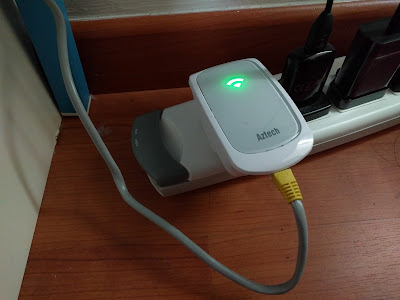We're well past the halfway point of 2016, and Sony's E3 announcements have done everything but disappoint. A bevy of incredible games for the PlayStation 4 are on the way, and here are a few that I am rather excited for:
That kind of speed is definitely not acceptable for a modern day gaming console. My downloads are unbelievably slow, my Spotify won't even stream properly - and worse of all my online multiplayer games lag.
Because of how my Internet hardware is setup, there is simply no way at all that I can put in a direct Ethernet cable from my router to my PlayStation 4. So I decided on the next best thing: A Wi-Fi extender, or Wi-Fi repeater - whatever its called.
If you're having the same Wi-Fi issue with your PS4 as I am, you can try picking up the Aztech Wi-Fi repeater here.
- The Last Guardian, which has been in development for years apparently - it is also the conclusion to the trilogy of Ico and Shadow of the Colossus. Releases in 2017, though.
- Horizon: Zero Dawn, hunting mecha-dinosaurs with high tech bows. What else do you need? It's by Killzone's developers too.
- No Man's Sky, an inter-planet exploration game that is uniquely generated for each single play through.
- Day's Gone, open-world zombie survival kinda game.
- Gran Turismo: Sport, Gran Turismo finally comes to PlayStation 4
Sony's also placed a lot of emphasis on Project Morpheus, their PlayStation VR headset. Many games had a PlayStation VR demo at E3 - Sony is really pushing this one. Oh, Hideo Kojima's back too.
But let's push all that aside for now and talk about the PlayStation 4's Wi-Fi: It is pretty trash. There, I've said it. Seriously, for a modern-day console, I am very surprised at how bad the Wi-Fi connectivity for the PS4 can be.
Let's Fix the PS4's Wi-Fi
Here is how my setup goes: My router sits downstairs, while my laptop and PS4 is up in my room. My laptop and other mobile devices can achieve Wi-Fi speeds of about 28-30 Mbps download an about 9-10 Mbps of upload (I'm using TMnet's 30 Mbps Unifi plan), but the PlayStation 4 can only do this:
32.7 kbps download and 1.1 Mbps upload?!
That kind of speed is definitely not acceptable for a modern day gaming console. My downloads are unbelievably slow, my Spotify won't even stream properly - and worse of all my online multiplayer games lag.
Because of how my Internet hardware is setup, there is simply no way at all that I can put in a direct Ethernet cable from my router to my PlayStation 4. So I decided on the next best thing: A Wi-Fi extender, or Wi-Fi repeater - whatever its called.
What does a Wi-Fi repeater/extender do?
Well, it does exactly what its name suggests: It extends your Wi-Fi connection by sort of repeating it again to other devices nearby. Not wanting to spend a lot, I set out to get the cheapest Wi-Fi extender I can get: the Aztech WL559E wall-plugged 300Mbps Wi-Fi repeater.
The Aztech repeater in "bridge mode" with a direct Ethernet out to my PS4.
Since I've also established the fact that the PlayStation 4's Wi-Fi capability is pretty crap at this point, I set up the Aztech repeater into "bridge mode". What bridge mode essentially does is to pick up a Wi-Fi signal, and then output it via an Ethernet cable to a computer or gaming console - thus bridging the gap, ha!
So after setting up the Aztech repeater with my laptop (you gotta plug the repeater in to the laptop via Ethernet to set it up beforehand), I plug the Aztech repeater into my power extension, and then route an Ethernet cable from it straight into my PlayStation 4 and voila:
An impressive 21.0 Mbps download and 3.6 Mbps upload! Hurrah!
It's an incredibly simple fix and costs me no more than RM80 for the Wi-Fi repeater. I can now officially say good bye to slow downloads and multiplayer lags on my PlayStation 4.
If you're having the same Wi-Fi issue with your PS4 as I am, you can try picking up the Aztech Wi-Fi repeater here.
If you wanna catch a game with me on PlayStation Network or just wanna drop a message, do hit up my PSN profile that you can find at the top of the page. I'm currently having a go at GTA V and Battlefield 4 again.

















.jpg)







